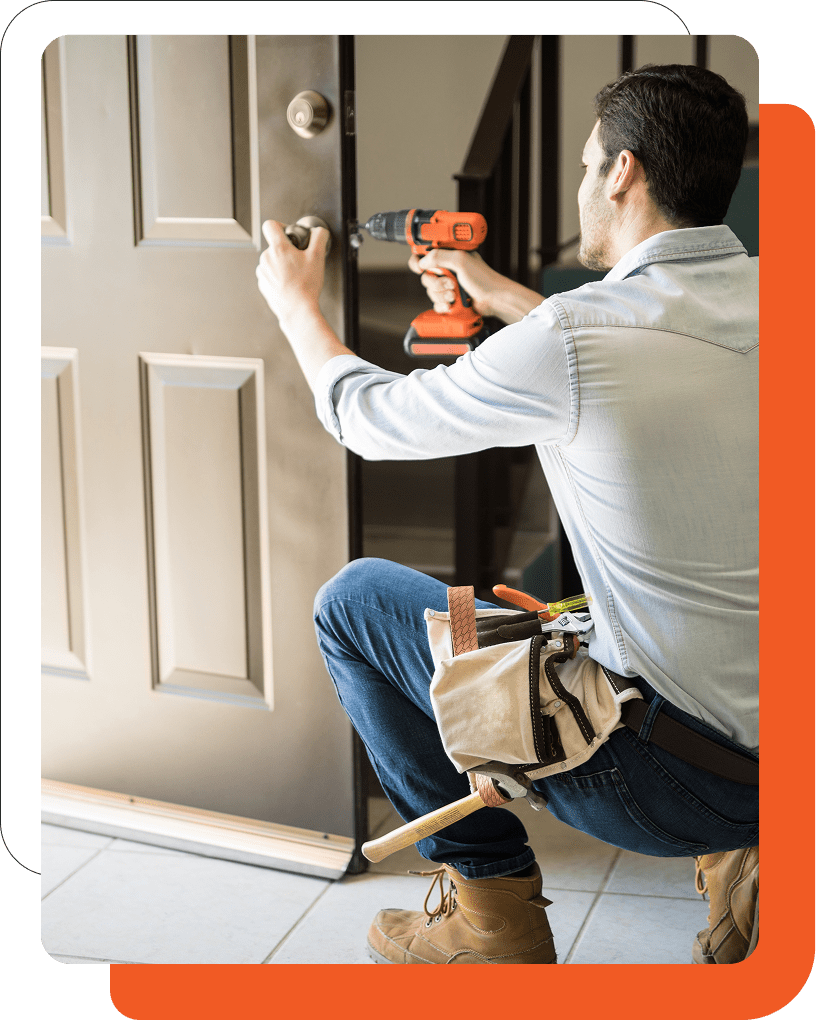The primary difference between door locks and door latches is that locks require a key to open the door, but a latch does not. As the name implies, a door lock ensures that your door is locked, while for latches, the door may be closed but definitely not locked. Both door locks and door latches play the same role, which is to offer you security.
However, the security level both of them offer depends on the type of door locks or latches installed on your door. While some door locks and latches are made from durable materials, others are not, and this can affect their effectiveness in keeping out unwanted guests from your homes or property.
Understanding the Differences Between Door Locks and Door Latches
We will give a detailed description of door locks and latches to explain the difference between door locks and door latches. We will also highlight the different door latch types and describe a door latch mechanism. Since we discuss the difference between door locks and door latches, we will also list the types of door locks and explain how a door lock works.
Description
Door latches are very common and may be found in your workplace, house, or any other building with an entry or exit. A latch allows you to open and close a door, and you can link it to your preferred choice of doorknob or handle. A door latch shuts when the door is closed and opens when you operate the handle. On the other hand, door locks are electronic or mechanical devices that can be used to fasten a door and be released by key or other objects such as security tokens, keycards, fingerprints, etc.
Security
Locks offer more security to doors than the use of door latches. When a door is shut using a latch, it remains open, although no one can gain entry through the door without first removing the latch. With a lock, you may be guaranteed a higher security system for your home or office spaces, especially with advanced security door lock types like a fingerprint, keycard, RFID card, and facial recognition. With a keyed lock, you can control access to a specific room in your house. You can also match keyed locks so that a single key can open all the locks in your house.
Types of Door Locks and Door Latches
There are different door locks and door latch types available in hardware stores. Each of these locks and latches has what makes them stand out as well as their drawbacks.
Types of Door Locks
Door locks are made to guarantee optimal security for homes and other locations. The following are types of door locks.
-
Knob Locks
The most common door lock type you will find is the knob locks. They are mostly used in homes to secure doors. A knob lock has a lock cylinder that is located inside the know and not the door. It is not advisable to use knob locks on external doors because an intruder can easily break the lock using a wrench or hammer. They are better suited for internal doors.
-
Cam locks
Calm locks are fastening devices that are constructed mostly on cabinets for storing items. They are installed on the wooden parts of cabinets and are cylindrical in shape. They often come with cabinet kits on different furniture sets. The locking mechanism of cam locks comprises several cams or tailpieces, making them suitable for low-security applications like drawers, cabinets, and mailboxes.
-
Deadbolt
Deadbolts are highly reliable when preventing break-in or burglary. The locking mechanism of deadbolts involves turning a key or knob without the use of a spring. They can help resist boring, battering, and other forms of physical attacks. It isn’t easy to open deadbolts with a knife or any other hand tool.
-
Padlocks
Padlocks are classified as freestanding locks because you do not permanently attach them to a door or cabinet. Padlocks are categorized into a combination and keyed. Keyed padlocks are mobile and easy to identify. They are also effective in providing security for drawers, lockers, sheds, and trash units.
-
Mortise Locks
Mortise locks are highly effective for external doors. Mortice locks have an internal system that aligns them to the category of locksets than locks. Mortice locks are suitable for use in neighborhoods with high crime rates because of the level of security they provide. You can use mortise locks on apartment doors, entry glass doors, or commercial doors.
Types of Door Latches
The following are door latch types that effectively offer top security to your doors at home or other locations.
-
Roller bolt latches
Roller bolt latches are designed with a pull handle or a cupboard knob. When the roller slots slide into the strike plate of your door frame, it closes the door. The force exerted in opening or closing the door can be varied to adjust the spring.
-
Tubular latches
Tubular latches are used with privacy door handles or latch door handles. The position of the spindle at the door handle center depends on the latch length. It may also contain holes that allow bolts to pass through them.
-
Deadbolt latches
Deadbolt latches offer high security for homes. Deadbolt latches also have a lock mechanism that prevents forceful retraction of the single through-bolt, making it effective for front doors.
-
Toggle latch
The toggle latch has a claw that catches the strike plate at a particular position. Toggle latches provide you with an effective way of securing your front door without a key.
-
Pawl latch
Pawl latches give room for one-directional movement and do well to prevent any return motion. For optimal security, you can use pawl latches with a ratchet wheel.
-
Rim latches
Rim door locks and latches allow the opening of doors by turning the doorknob. The latch is operated by a button that is pushed to lock the door from a single position.
Door Locks Mechanism vs. Door Latches Mechanism
The door locks’ mechanism and that of door latches can be used as a difference between door locks and door latches. Let us see the basic difference between these two distinctive door mechanisms.
Mechanism of a door latch
The mechanism of a door latch comprises a cylinder or a tubular latch in some cases. The cylinder is driven through the door edge. The latch mechanism comprises a spring-loaded latch that causes the door to open when it retracts. The door becomes closed when you release the door lever or knob. It then extends to ensure that your door is closed. The door latch mechanism is designed with attached mortice plates for exterior doors that may require you to chisel the door edge. Doing this ensures that the mortice plates rest correctly in the door.
Door lock mechanism
The term lock mechanism is generic and includes all the parts that are assembled inside a lock. A lock mechanism for door locks may further contain a disk tumbler mechanism, pin tumbler mechanism, or warded mechanism based on its construction. There are three different door lock mechanisms, including electric lock mechanism, combination lock mechanism, and key operated lock mechanism. Each door lock mechanism has unique ways of repair, installation operation.
How to Replace a Faulty Door Latch
Door latch locks can become faulty or wear out over time. You may have to fix or replace the latch. Here is how to replace a faulty or damaged door latch lock. The first step is to remove the damaged door latch lock using a screwdriver to remove the handle. The next step is to lose the screws that hold the plate facing the frame of your door. That. You should remove the spindle and the faulty latch. Gently replace the new latch into your door frame and then reassemble the parts. You should then replace the spindle and screw the front plate of the latch. Do not also forget to replace the door handles and screw them back in place.
How to Replace a Faulty Door Lock
Different issues may arise with a door lock. It may be that your lock is broken or that it is jammed. You can either fix these door lock issues yourself or get a professional locksmith to do it. Replacing a door lock depends on the type of lock. For electronic or keyless door locks, you may have to reconfigure the lock or change the entire locking mechanism if there is extensive damage to the door lock.
You may have to take out the spindle for mortise locks and the mortice lock handles by unscrewing the screws holding the lock to your door. Once you have removed the lock, you can then replace it with the new look and fit in the spindle to both lock handles before screwing the lock in place.
Summary of the Differences between Door Locks and Door Latches
Door locks and door latches have a similar goal: to offer security to your home and property. While door latch locks may not require a key to open the latch, door locks require you to use a key or any other device to initiate the opening or closing of your doors. Door locks also offer higher security than door latches and may be used in front doors and other commercial properties. Both types of lock mechanisms are highly essential to safeguarding your home and property.









